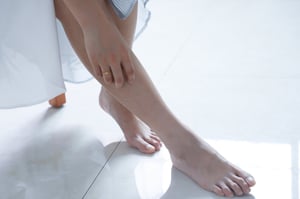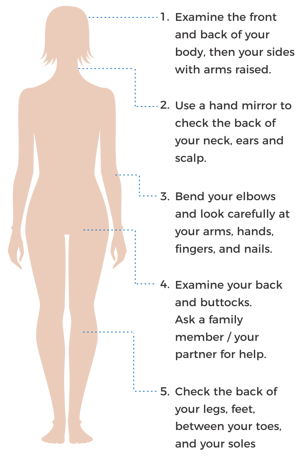Your self-check skin cancer guide
Getting to know your skin gives you the best chance of finding and treating skin cancer early. Regular professional skin checks are a fact of life for all Australians, but most of us only see our doctor for a full-body skin examination once a year, or more frequently if we are at high risk of developing skin cancer.
 In between visits to the skin cancer doctor, the person most likely to notice an irregular spot on your skin is you. Skin cancer effects two in three Australians by the age of 70, but it doesn't have to be deadly if it's caught early. If you keep track of new and changing moles, and get them checked by your doctor if they are concerning, then you stand the best chance of catching the disease before it requires invasive treatment or spreads to other parts of your body.
In between visits to the skin cancer doctor, the person most likely to notice an irregular spot on your skin is you. Skin cancer effects two in three Australians by the age of 70, but it doesn't have to be deadly if it's caught early. If you keep track of new and changing moles, and get them checked by your doctor if they are concerning, then you stand the best chance of catching the disease before it requires invasive treatment or spreads to other parts of your body.
How to self-monitor your skin
1. Know your skin cancer risk
Are you at increased risk of developing skin cancer? Take our quick quiz to find out. You may be at higher risk of developing skin cancer if you grew up in a sunny country like Australia, have fair skin or light-coloured hair, have multiple moles, or have a previous history of skin cancer - among other factors such as your age and gender.
If you have a family history of melanoma, you are also at higher risk of developing that form of skin cancer, which can spread to other parts of your body and become fatal. It's vital to be aware of your skin cancer risk so you can be alert for changes in your skin.

2. Check your whole body
Skin cancer can develop anywhere on your body - not just sun-exposed areas. You can develop the disease inside your mouth, in your eyes, under your fingernails, between your toes, and underneath the hair on your scalp. It's vital that you self-monitor your entire body and ask a friend, family member or partner for help checking the areas you can't see.
3. Look for changes in the size, shape or colour of moles
The most significant warning sign of skin cancer is a new spot on the skin or a spot that is changing in size, shape or colour. Some cancers also stand out as a spot that looks different from all the others on your skin. If you have a new, changing or stand-out mole, get it checked as soon as you can. Early detection of skin cancer increases your chances of survival to 98 per cent.
The ABCDE guide is handy for checking whether your moles are developing symptoms of skin cancer - specifically melanoma. Monitor your skin and tell your doctor if you notice any signs:
AsymmetryDo the two halves of the lesion match if you draw a line through the middle? |
 |
 |
BorderAre the borders smooth and even or do they have notched and. |
 |
 |
ColourDoes the lesion have one colour or a variety of colours? |
 |
 |
DiameterIs the lesion smaller or larger than a pencil eraser which is. |
 |
 |
EvolvingAre there any changes in size, shape, colour, elevation or any other new |
3. Know the warning signs
In addition to the ABCDE guide, other warning signs of skin cancer include:
- A sore that doesn’t heal
- Spread of colour from the border of a mole into the surrounding skin
- Redness or swelling beyond the border of the mole
- Change in sensation, such as itchiness, tenderness, or pain
- Scaliness, oozing, bleeding, or the appearance of a lump or bump.
You might like to photograph your moles so you can track their changes over time. If you become worried about any spots on your skin, book a skin check with your doctor straight away.
- Tags:
- Detection
